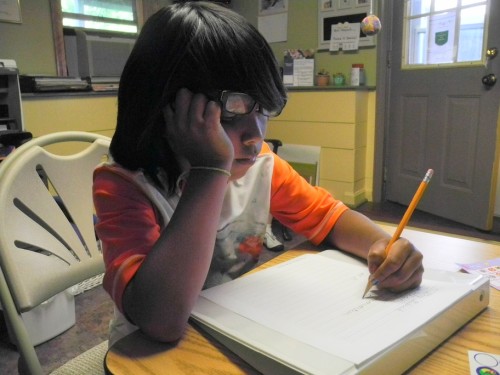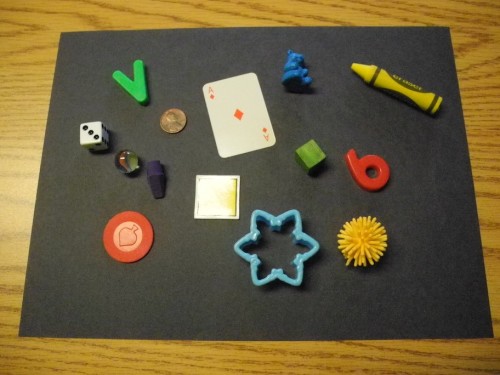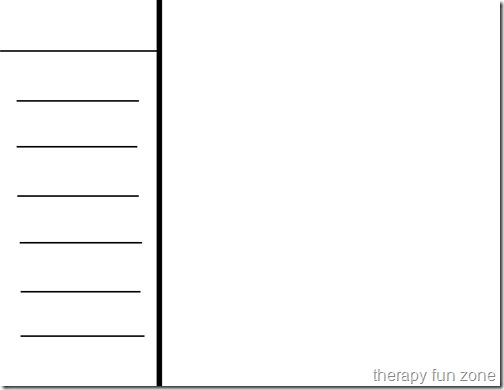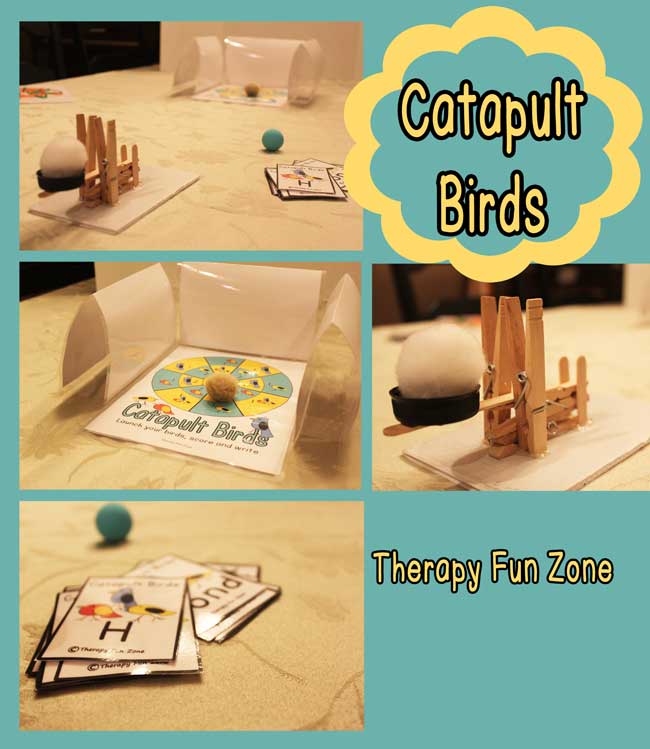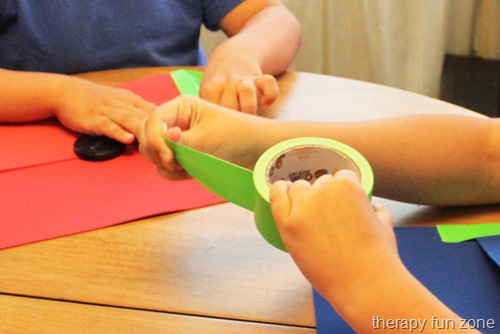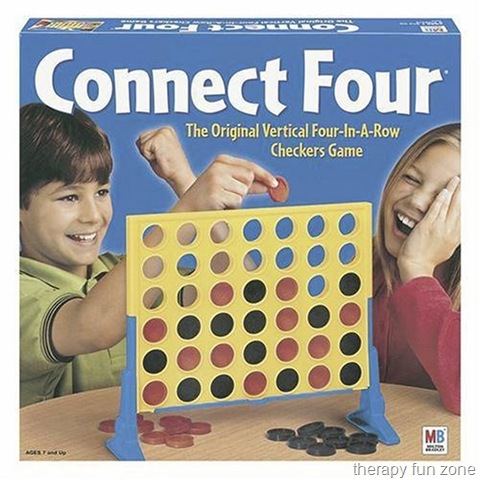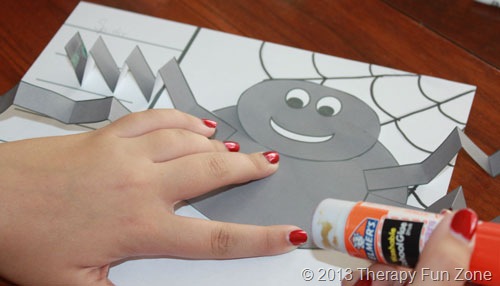Do You See Me Now? I’m Figure-Ground Discrimination!
This post may contain affiliate links.
A Guest post from our regular contributor, Katherine Collmer.
If I’ve learned anything at all during my 15+ years as an occupational therapist, it’s that OT-speak can be confusing! Proprioception, sensory modulation, visual memory and visual closure are all just a jumble of words written in the language of OT, mostly indecipherable to parents, teachers and students. I’ve discovered that too much of that lingo in a report or in conversation usually results in glassy eyes and head shaking. Figure-Ground Discrimination falls right into the “What is THAT?” category. Each time that I explain it, I think about the many occasions that I’ve done that in the past. I cannot avoid its’ mention since the concept is such an essential ingredient for efficient handwriting. The fact that I will be required to explain it again and again has led me to explore more efficient strategies for doing so.

Take a look at this picture of a garden. What do you see? Green ground cover and some chips? How about the ducks? And what about a bee? (If you are having difficulty with that one, try clicking on the picture for a larger view!) They are the keys to our discussion about figure-ground discrimination. Since it is a visual skill, efficient figure-ground discrimination depends upon our ability to become aware of and come to understand information that is coming in through our senses – in this case our eyes. In order to make sense out of this picture, we need to “pick out” the ducks and make the association between them and the surrounding aspects of the picture. They are peeking out from behind the ground cover, sort of sneaking up on us. All of these are parts of the “whole” picture as well as separate pieces of information in themselves. Our eyes are taking in the entire snapshot; but we are attending to the portion of it that we need to “see” for now. When we read a book or write a sentence, it is essential that we be able to separate the words from the background upon which they are written or to separate them from the pictures or lines on the page. Barbara Smith, The Recycling OT, in her book From Rattles to Writing gives us a straight-forward breakdown of this skill: “The figure is the object that your child is interested in seeing. The ground is the background or area surrounding the figure.” During handwriting tasks, figure-ground discrimination skills are those that give us the ability to scan the page and look for errors, or to find the correct place on the line to write the letters in the first place! Legible handwriting that can be produced smoothly and fluidly relies on a complex set of visual skills. One of these is the ability to visually keep your place on the paper when copying from a book or the board – another is being able to shift your attention between the words you have written on a page and those you are currently writing in order to make sense of the story – and yet another is the ability to organize your own written material on a page efficiently so that it can be understood by the reader. Figure-Ground Discrimination!
So, how do we know when a child is having difficulty with Figure-Ground Discrimination? Vision skills are sneaky little guys. Sometimes they are uncovered because a child holds his book close to his face or squints. Other times they can be discovered because a child rubs his eyes or covers one eye. There are a whole host of symptoms that can lead us to believe that a student may be suffering from poor vision. (A handy list can be found on my Links and Resources Page. Look for “Spotting Red Flags Checklist Teacher Presentations.”) But Figure-Ground Discrimination can also present itself through silent behaviors that can cause both parents and teachers to feel that their student is lazy or has a learning disability. Here are some of those behaviors:
· He can’t follow the train of thought with writing or reading, seeming to go too fast in order to simply get it done.
· He has little interest in age-appropriate visual activities such as I Spy and appears to be disinterested in reading “fun” books (e.g., comics) for pleasure.
· He fumbles around and fidgets during written work and doesn’t seem to be concerned about not finishing on time.
· He has difficulty copying from the board, often appearing to be sloppy and not interested in getting down the correct information.
What should you do if you feel that your student is struggling with Figure-Ground Discrimination? First of all, if you find that he displays the behaviors above, as well as some of those on my “Spotting Red Flags” checklist, then it is important that you make an appointment to have his vision assessed by a Developmental Optometrist! This should be the first step toward helping your child with any possible vision skill concerns. You can find one in your area by clicking on Locate A Doctor here.
Next, you can try some of these activities with your student for extra (and fun) Figure-Ground Discrimination practice. IMPORTANT NOTE: QUALITY VERSUS QUANTITY. This skill is challenging for him; so, use these practice ideas in small bits – 5 minutes at a time in the beginning. When he stops struggling, add some more time. But, remember, if it’s not fun, chances are there’ll be less benefit.
1. Color-by-Number. This activity provides him with opportunities to use his visual scanning skills to locate the correct number amidst a busy page, with little help from his depth perception skills. The complexity of the color-by-number activity determines how much of a challenge you offer him. Guide him to seek-and-locate one number at a time, finishing all of number one before moving on to number two.
2. Hidden Pictures. These activities truly match Barbara Smith’s definition of Figure-Ground Discrimination. The busy background, often not making sense (e.g., chairs in trees,
stars on the ground) provide a child with opportunities to develop both scanning and attending skills. For students who are struggling with figure-ground discrimination during board games or activities sheets, you can build your own hidden picture game with items from your home or clinic. This adds a 3-D element to the challenge that allows the use of his depth perception skills to help him find the object. Move on to more challenging paper-and-pencil activities when he has mastered these.
3. Board Games. Children and students of all ages can benefit from board games that offer opportunities to scan, match and attend to particular pieces of information. Barbara Smith suggests Candy Land for the young ones as it requires matching a particular card with one on the busy board. Scrabble and Scrabble Junior are two of my go-to games that encourage the development of both figure-ground discrimination and letter/word recognition skills. Sequence is one of my favorites as it offers children a chance to work on their figure-ground discrimination while they hone their critical thinking skills. I have the travel edition that uses pegs and does a fine job on fine motor skills, as well! Bingo and Zingo can work on figure-ground discrimination with a bit of letters, words or numbers mixed in!
4. Activities on a Budget. A deck of cards, a box of plastic alphabet letters or a game of hide-and-seek can provide great figure-ground discrimination “work” without having to dish out too much money. Solitaire and Sequence can be played with any deck of cards. Alphabet letters can be mixed up on the table so that a preschooler can scan them, find the letters of the alphabet in sequence and match them to an alphabet cookie sheet. Paper towel cardboard tubes can be used to “spy” around the room in search of hidden objects. So much fun without too much dough!
Figure-Ground Discrimination is easier to explain when you use less language and more demonstration. These simple activities in your tool kit can provide the “just right” fit for each child.
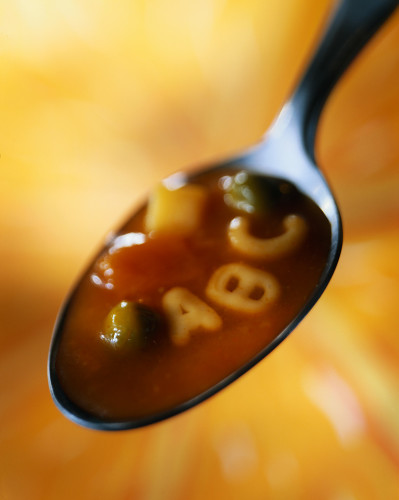
So, if you can find the letters in the alphabet soup, chances are you are not figure-ground challenged! But, if you know a child who would have difficulty telling you that they are there, or how many there are (even though he has no difficulty with counting skills), you might want to discuss this with the parent, an occupational therapist, or your developmental optometrist. The child will thank you for it.
Katherine J. Collmer, M.Ed., OTR/L, is a pediatric occupational therapist who owns and operates a clinic that specializes in the assessment and remediation of handwriting skills. She can be contacted via her website, www.handwritingwithkatherine.com.

